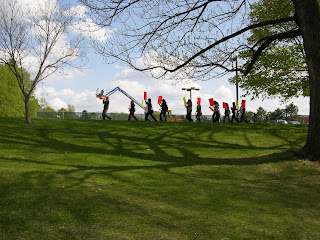
 Something that had currently developed a lot of absurd meaning for Paige was the U of R's Parking Administration. It's a well known fact on campus that Parking Services truly exemplifie the money draining nature of the already exorbitantly expensive University. (Most other colleges have free parking!) After purchasing a pricey parking permit to have a spot that's inevitably 1 mile from anywhere you need to be, Parking Services go out of there way to give excessive $20-$200 tickets for whatever parking violation they see fit. The catch is that you can't receive your hard-earned diploma until you've paid off your parking tickets (whether or not they are deserved). To top that, when you do go to pay off a ticket, the staff is highly rude, somehow acting more irritated by the fact that you got the ticket than you are yourself!
Something that had currently developed a lot of absurd meaning for Paige was the U of R's Parking Administration. It's a well known fact on campus that Parking Services truly exemplifie the money draining nature of the already exorbitantly expensive University. (Most other colleges have free parking!) After purchasing a pricey parking permit to have a spot that's inevitably 1 mile from anywhere you need to be, Parking Services go out of there way to give excessive $20-$200 tickets for whatever parking violation they see fit. The catch is that you can't receive your hard-earned diploma until you've paid off your parking tickets (whether or not they are deserved). To top that, when you do go to pay off a ticket, the staff is highly rude, somehow acting more irritated by the fact that you got the ticket than you are yourself!After receiving her own fair share of parking tickets, Paige decided to experience a day in the life of a Parking "Cop." She scanned one of her own tickets and made dozens of copies. All of the violation information was cleared so that she wouldn't be traced back to the ticket. On the bottom though, she added something new, "You can't graduate 'til you pay us, sucka!"
Cloked in a hood, a shady looking Paige went around different parking lots, picking and choosing whichever cars she wished to ticket. She wasn't able to see the first hand reactions of those who were ticketed but she did hear some later feedback. A classmate angrily texted her after the day because she was tricked into believing she actually had an expensive parket ticket, until closely evaluating the slip. A few days later, one of Paige's co-workers had mentioned that her friend had received a bizarre parking ticket, thinking that it was actually the doing of Parking Services! One can only hope that Parking Administration recieved their fair share of complaints and dirty looks.


























